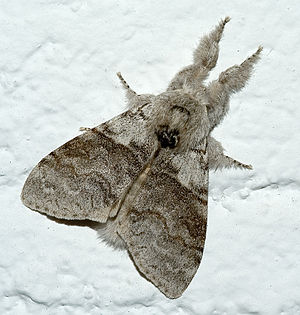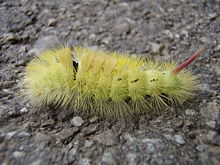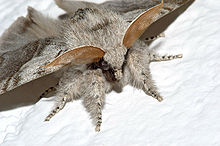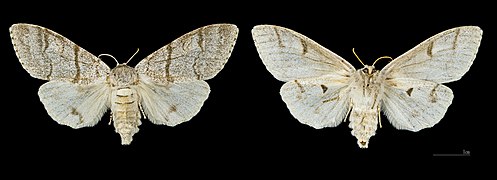Beech extensor foot
| Beech extensor foot | ||||||||||||
|---|---|---|---|---|---|---|---|---|---|---|---|---|

Beech extensor foot ( Calliteara pudibunda ) |
||||||||||||
| Systematics | ||||||||||||
|
||||||||||||
| Scientific name | ||||||||||||
| Calliteara pudibunda | ||||||||||||
| ( Linnaeus , 1758) |
The beech extensor foot ( Calliteara pudibunda ), also called beech redstart or shortened extensor foot or redstart , is a butterfly ( moth ) from the subfamily of the bearer moth (Lymantriinae) within the owl butterfly family (Noctuidae).
features
The moths reach a wingspan of 37 to 67 millimeters, while the females are usually significantly larger than the males. Their forewings are finely patterned light gray and have two to four dark serrated bands. In the males, the middle third of the wings are often darker brown or gray in color. There are both very light shapes, in which, in extreme cases, you can only see the dark serrated bandages on a light background, as well as dark shapes that are solidly colored dark brown or dark gray. The forelegs are densely hairy and elongated.
The caterpillars are about 50 millimeters long, with females often being larger than males, as in the case of adults. Their basic color is initially whitish-green or yellow-green, later strong yellow-green or brown-pink. The animals are noticeably hairy. They have numerous long hairs on the sides that are adapted to the basic color; on the back only after the seventh segment. On segments four to seven, they have very dense hairbrushes that are also very dense, like the basic color or very light-colored, upward-pointing hairbrushes. On the eleventh segment, they have another, rearward-facing, red or orange colored hairbrush that has significantly fewer but longer hair than the other tufts. In the pink-colored caterpillars, its color varies to black. The caterpillars between the segment rings are colored velvet black. These areas can be clearly seen when the caterpillars curl up in danger. The underside of the caterpillars are also velvet black.
Due to the tuft of red hair on the abdomen of the caterpillars, the moths are also called redtail . This name is also used for songbirds of the genus Phoenicurus used to the garden and Hausrotschwanz belong.
Similar species
- Fir extensor foot ( Calliteara abietis )
- Gorse extensor foot ( Calliteara fascelina )
Synonyms
- Dasychira pudibunda
- Elkneria pudibunda
Occurrence
The animals occur in almost all of Europe , except in the far north and parts of the Mediterranean region , east to the Caucasus . They live mainly in deciduous forests , but also in hedges, parks and gardens. They are common and widespread.
Way of life
The nocturnal moths can be attracted with artificial light, whereby the males in particular are attracted by the light. In their resting position, the animals stretch their front legs forward, which is why they got their German name.
Flight and caterpillar times
One generation of the moth flies from May to June, the caterpillars are found from July to October.
Food of the caterpillars
The caterpillars feed on various deciduous tree - and shrub species, especially of goat willow ( Salix caprea ), hornbeam ( Carpinus betulus ), beech ( Fagus sylvatica ), English oak ( Quercus robur ), European hazel ( Corylus avellana ), silver birch ( Betula pendula ), apple tree ( Malus domestica ) and mountain ash ( Sorbus aucuparia ).
development
The females lay single-layer ice sheets with up to 300 eggs on bark or branches. Initially, the caterpillars live gregariously, crowded together. But they become loners early on. When moulting, young caterpillars sit on a spun cushion on the underside of the leaf, while older caterpillars retreat into rolled leaves. Pupation takes place on the ground between the leaves in a gray or brown to yellowish cocoon with their hair offset . The pupa hibernates, the moths only hatch in spring when the temperatures are right. Mass proliferation of the beech extensor foot is not only known from historical times. However, since these occur late in the year, they have little impact on forestry.
swell
Individual evidence
- ^ A b Hans-Josef Weidemann, Jochen Köhler: Moths. Weirdos and hawkers. Naturbuch-Verlag, Augsburg 1996, ISBN 3-89440-128-1 , pp. 337f.
- ↑ a b c d Heiko Bellmann : The new cosmos butterfly guide. Butterflies, caterpillars and forage plants. Franckh-Kosmos, Stuttgart 2003, ISBN 3-440-09330-1 , p. 284.
- ↑ a b Manfred Koch : We identify butterflies. Volume 2: Bears, Spinners, Swarmers and Drills in Germany. 2nd, expanded edition. Neumann, Radebeul / Berlin 1964, DNB 452481929 , p. 84f.
- ↑ For example, a local mass occurrence in Denmark in 1998 on 20 hectares of beech forest on the island of Zealand is documented.




